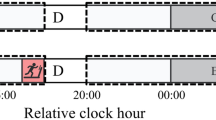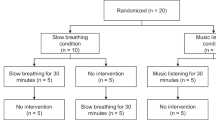Abstract
IT has been proposed that slow wave sleep (SWS) in humans is associated with somatic restitution1, and findings of increased plasma somatotrophin during SWS2, and of the greater amounts of SWS following exercise3,4 support this proposal. Others have, however, failed to show any exercise effects of sleep5,6. Exercise has been found to increase sleep somatotrophin levels, but not SWS7. These contradictory findings may in part be attributed to the large interstudy variations of administered exercise and fitness of subjects (in no study has exercise been standardised against individual work capacity); the time of day of exercise; the need for further qualification of SWS, defined8 here as sleep stages 3 and 4, respectively containing 20–50% by time of delta activity, and more than 50% delta activity. Up to 20% delta activity is included in the non-SWS stage 2. We have investigated the effects of the time of day of individually standardised amounts of exercise on subsequent sleep in which stage 2 was subdivided further between 10% and 20% delta activity (2ii).
This is a preview of subscription content, access via your institution
Access options
Subscribe to this journal
Receive 51 print issues and online access
$199.00 per year
only $3.90 per issue
Buy this article
- Purchase on Springer Link
- Instant access to full article PDF
Prices may be subject to local taxes which are calculated during checkout
Similar content being viewed by others
References
Oswald, I., Nature, 223, 893 (1969).
Sassin, J. F., et al., Science, 165, 1299 (1969).
Baekeland, F., and Lasky, R., Percept. Mot. Skills, 23, 1203 (1966).
Zloty, R. B., Burdick, J. A., and Adamson, J. D., Activ. nerv. sup. (Praha), 15, 217 (1973).
Hauri, P., Psychophysiology, 4, 267 (1968).
Zir, L. M., Smith, R. A., and Parker, D. C., J. clin. Edocr., 32, 662 (1971).
Adamson, L., Hunter, W. M., Ogunremi, O. O., Oswald, I., and Percy-Robb, I. W., J. Endocr., 62, 473 (1974).
Rechtschaffen, A., and Kales, A., A Manual of Standardised Terminology, Techniques and Scoring System for Sleep Stages of Human Subjects (US natn. Inst. Hlth, No. 204, 1968).
Astrand, I., Acta physiol. scand., 49, suppl., 169 (1960).
Author information
Authors and Affiliations
Rights and permissions
About this article
Cite this article
HORNE, J., PORTER, J. Exercise and human sleep. Nature 256, 573–575 (1975). https://doi.org/10.1038/256573a0
Received:
Accepted:
Issue Date:
DOI: https://doi.org/10.1038/256573a0
This article is cited by
-
Exercise improves the quality of slow-wave sleep by increasing slow-wave stability
Scientific Reports (2021)
-
To what extent can sleep be influenced by diurnal activity?
Experientia (1984)
-
Fitness facilitates sleep
European Journal of Applied Physiology and Occupational Physiology (1984)
-
Sleep and body restitution
Experientia (1980)
Comments
By submitting a comment you agree to abide by our Terms and Community Guidelines. If you find something abusive or that does not comply with our terms or guidelines please flag it as inappropriate.



